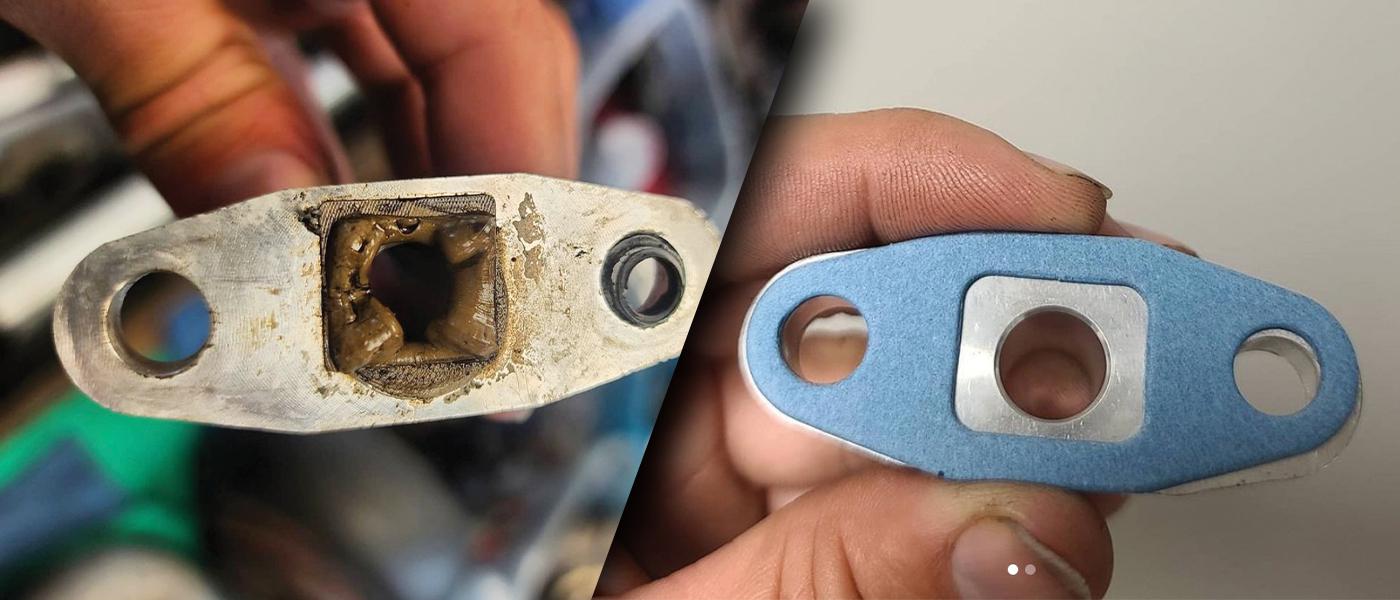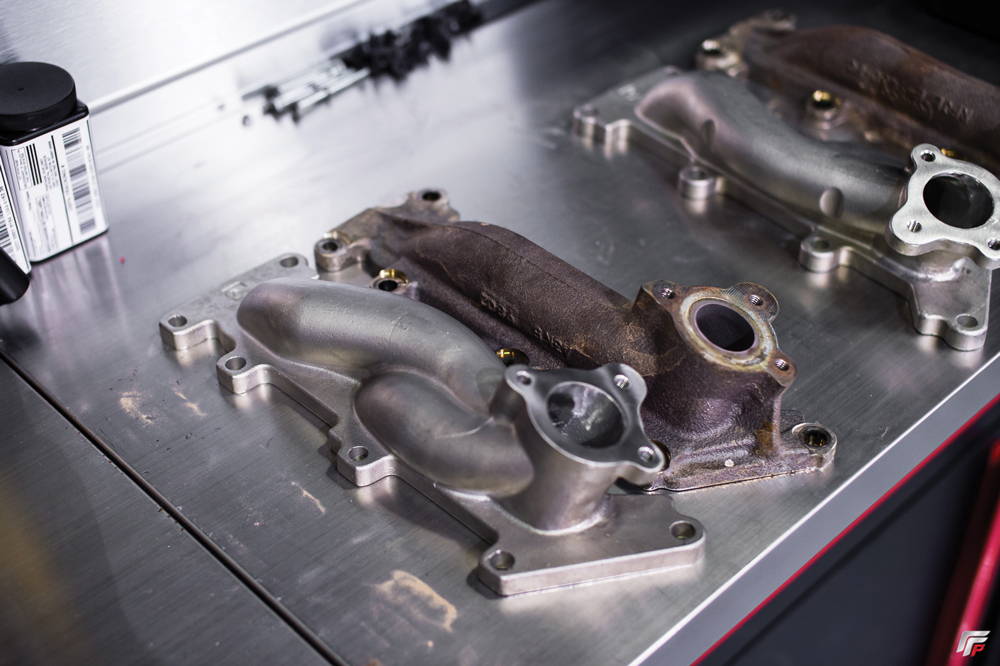Stop Doing That…Do This Instead: Turbocharger Installation

Turbo manufacturers and installers frequently troubleshoot problems for end users. Two common issues, seen here from left to right, involve using a gasket maker for the flange instead of a solid gasket, which blocks oil flow, and using flanges with holes that are too small. Photos courtesy of Boost Lab.
Getting the details right means the difference between making more power and destroying the whole system. Here’s how to ensure you’re on the correct path.
Power adders—and turbochargers in particular—are an integral part of racing’s quest for more performance. But as turbos grow more popular, and the demands put on them more extreme, the risks of making mistakes in their installation and use grow as well. We asked representatives from some leading turbocharger companies about the most common mistakes they see when their customers install a turbocharger system and how to fix them, or avoid them altogether.
Size—and Quality—Matter
“Most people are using turbos that are way too big,” said Geoff Raicer of Full-Race Motorsports, Phoenix, Arizona. “A lot of enthusiasts are focused on peak horsepower for drag racing and don’t know how a large turbo is going to behave during the 98% of the time you’re not at wide-open throttle. An overly large turbo can be terribly laggy and ruin what makes the vehicle fun to drive.”
“Stop using turbos designed for 1970s John Deere diesel tractors on gasoline race engines,” said Kevin Kenney of AGP Turbo, Tempe, Arizona. When asked if that really happens, Kenney said, “Oh, yes. All the customer sees is a 56-mm turbo for cheap. A few hundred dollars more will get you better performance in every way. Every gasoline engine displacement, rpm band, compression, and target boost level will require different precise matching. The compressor wheel size and design, compressor housing, turbine housing, and turbine wheel size and design need to match all the aspects of the engine.”
Proper sizing doesn’t have to be difficult, Raicer said. “We help people with these calculations every single day. There are some YouTube tutorials on the BorgWarner MatchBot page that can help walk you through the process before you contact Full-Race.”
Blowing Smoke
Reggie Wynn of Turbonetics in Moorpark, California, has years of experience responding to end users’ questions, including turbocharger oiling systems. “The customer will call and say, ‘My turbo’s smoking.’ They want to blame the turbo, but most of the time it’s an installation error.” Because the oil coming out of the turbocharger’s center housing rotating assembly (CHRA) is not pressurized, “any restriction is going to cause smoking from the turbo.”
Most of the remedies are straightforward. Use a gasket, not gasket maker, on the oil drain flange, Wynn said. “You cannot control where the gasket maker goes when you squeeze the flange onto the surface of the CHRA. You don’t want it in the passage where the oil comes out.”
Also, beware of oil drain flanges with small passages. “We recommend using a -10 on the oil drain for your average turbo. That comes out to about 3/4 or 5/8 of an inch. The size of the hole in the flange needs to be the size of the hole in the gasket.”
When plumbing oil lines, “turbos and 90s do not get along,” Wynn said, referring to the angle of an oil drain fitting. “Since the oil’s not pressurized, it will make an abrupt stop, back up into the drain, and follow the path of least resistance, which will be that rear piston ring.” Wynn recommends at most 45-degree fittings.

And since the return oil isn’t pressurized, be sure the oil returns to the pan “above the oil level in the pan,” Wynn said, not at the bottom of the pan. “It can’t fight the oil that’s already in there.”
“It’s critical to prime a turbo with oil before its initial startup, especially if it’s a journal-bearing turbo,” Raicer said. “If you don’t, it may experience enough wear on initial startup that the turbocharger’s life can be shortened.”
Strong Foundation
Raicer said it’s “critically important” to select the right turbo manifold. “The manifold is the foundation of the whole turbo system. If you get the manifold wrong, the entire turbo system will be wrong.”
Two key elements of manifold selection are the “design component—the runner geometry and turbo position—and the materials and fabrication method,” Raicer said. Log manifolds, while inexpensive, can be problematic in their design, as they’re basically “just an open tube, where all the ports feed into each other and the exhaust pulses smash into each other. The engine basically exhales through a bottleneck. It’s bad for volumetric efficiency and turbine efficiency.”
Poor construction methods, such as “thin-wall, low-grade tubing, stamped collectors instead of fabricated collectors, and MIG instead of back-purged TIG welding can ruin a decent design,” Raicer said. “Before you know it, those things can cause 25%, 30%, even 40% losses coming from a leak or a crack.”
A high-quality fabricated manifold doesn’t have those issues, but fabricated manifolds “are labor intensive, and it costs so much in material and argon to properly fabricate turbo manifolds,” Raicer said. An alternative is investment-cast tubular designs. “With investment-cast stainless-steel or Inconel manifolds, we’re creating longish runners and more thoughtful runner geometry in turbo manifolds that don’t have the downsides of log manifolds or the constraints of fabricated manifolds.”
SOURCES
–
AGP Turbo
agpturbo.com
Full-Race Motorsports
full-race.com
Turbonetics
turboneticsinc.com/performance
 MEMBERSHIP LOGIN
MEMBERSHIP LOGIN JOIN PRI
JOIN PRI


